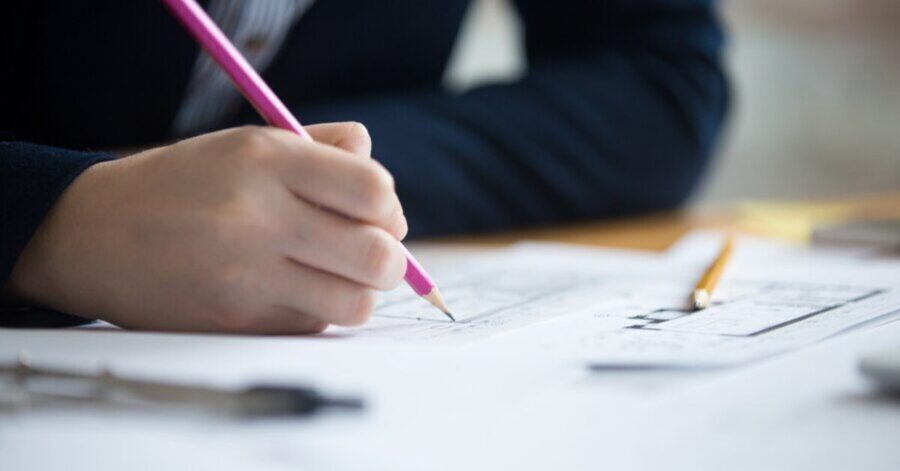11 December 2024
10 minutes read
Latest GMAT Format and Section Breakdown: GMAT Exam Pattern

Key Takeaways:
- The GMAT’s computer-adaptive format is a game-changer—mastering its nuances is just as crucial as knowing the content.
- Strategic section ordering can play to your strengths, so choose wisely based on your energy levels and confidence areas.
- Each GMAT section tests distinct skills; tailor your prep to address the unique demands of AWA, IR, Quant, and Verbal.
- Early preparation (3-6 months out) with full-length practice tests under exam conditions is your ticket to test-day readiness.
Are you gearing up for the GMAT but feeling overwhelmed by conflicting information about the exam structure? You’re not alone. Many aspiring MBA candidates struggle to navigate the maze of GMAT prep materials, often unsure if they’re focusing on the right areas or if their study strategies align with the current exam format.
This uncertainty can lead to misplaced effort and unnecessary stress. But don’t worry—we’ve got you covered. In this comprehensive guide, we’ll demystify the latest GMAT format and provide a clear breakdown of each section. By the end of this post, you’ll have a solid understanding of what to expect on test day and how to tailor your preparation for cracking the GMAT.
GMAT Exam Format

Before you take the GMAT, it’s crucial to understand its exam structure. The Graduate Management Admission Test (GMAT) is designed to assess your analytical, writing, quantitative, verbal, and reading skills. The format of the GMAT is unique, and familiarizing yourself with it is key to your success.
The GMAT test-taking format is computer-adaptive, and its pattern comprises four distinct sections. When the exam begins, you’ll have the flexibility to choose the order in which you tackle these sections. Let’s break down how the GMAT is divided into four sections:
- Analytical Writing Assessment (AWA) – 30 minutes
- Integrated Reasoning (IR) – 30 minutes, 12 questions
- Quantitative Reasoning – 62 minutes, 31 questions
- Verbal Reasoning – 65 minutes, 36 questions
The level of questions adapts to your performance, meaning the better you do, the harder the questions become. To prepare effectively, use official GMAT practice tests that mimic the real exam environment. Many test-takers find communities like GMAT Club invaluable for sharing experiences and strategies about the latest GMAT exam.
Understanding the GMAT exam structure is your first step toward mastering this important milestone in your MBA journey. By strategically preparing for each section, you’ll be well-equipped to handle whatever the test throws your way.
Analytical Writing Assessment for GMAT
The Analytical Writing Assessment (AWA) is your first challenge on test day. This section presents you with a passage containing an argument, and your task is to analyze its logical soundness. Unlike the next question types you’ll encounter, the AWA doesn’t test your subject knowledge but your critical thinking and writing skills. Here’s what you need to know:
- You have 30 minutes to read the passage, evaluate the argument, and compose your essay.
- The topic is general enough that no specialized knowledge is required.
- Your essay is scored on a scale from 0 to 6, with half-point increments.
- Two independent readers rate your essay; if their scores differ by more than a point, a third reader steps in.
While the AWA might seem disconnected from the multiple-choice sections that follow, it actually preps your brain for the critical reasoning and reading comprehension tasks ahead. Think of it as a warm-up for your analytical muscles. You can also gain idea of harder areas like the GMAT boldface strategy to gain an upper hand.
Remember, a strong AWA score can set you apart, especially if your overall GMAT score is borderline. Business schools value clear, concise communication, so don’t underestimate this section. Practice analyzing arguments and articulating your thoughts within the time limit to ensure you’re ready when test day arrives.
Integrated Reasoning for GMAT
The Integrated Reasoning (IR) section tests your ability to analyze data from multiple sources and in different formats. It’s designed to mimic real-world business scenarios where you’ll need to make decisions based on complex information. Here’s what you’ll face:
A. 12 questions in 30 minutes
B. Four question types:
- Graphics Interpretation: Interpret data from graphs or charts
- Two-Part Analysis: Solve complex problems with multiple variables
- Table Analysis: Sort and analyze data from tables
- Multi-Source Reasoning: Synthesize information from multiple sources
Most test-takers find IR to be of medium difficulty, falling somewhere between the Quantitative and Verbal sections in terms of challenge. The key is to practice efficiently managing your GMAT time while extracting relevant data.
Each question in IR requires multiple responses, and you must get all parts correct to earn points. This all-or-nothing scoring can be daunting, but it also means that educated guessing on one part can still lead to full credit if the rest are correct. You need to do your homework and practice GMAT critical reasoning questions to get a hang of it.
While IR doesn’t contribute to your 200-800 GMAT score, it’s reported separately and can influence admissions decisions. The skills tested here—data interpretation, critical reasoning, and information synthesis—are crucial for success in business school and beyond.
So, don’t overlook IR in your prep. Familiarize yourself with the question types, especially graphics interpretation, and practice working with diverse data sets. Your future MBA coursework will thank you!
Quantitative Reasoning for GMAT
The Quantitative Reasoning section, often called GMAT Quant, evaluates your ability to draw data insights and solve mathematical problems. This section is crucial for achieving a good GMAT score, especially if you’re aiming for top business schools. Here’s what you need to know:
A. 31 questions in 62 minutes
B. Two question types:
- Problem Solving: Traditional multiple-choice math questions
- Data Sufficiency: Unique to the GMAT, testing your analytical skills more than pure math ability
GMAT Quant covers topics like arithmetic, algebra, and geometry, but don’t let that intimidate you. Practice the GMAT functions questions and gain a better understanding of the GMAT accounting test with the help of good samples and do the same for all your pain points. The GMAC (Graduate Management Admission Council) designs questions to test your reasoning rather than complex calculations.
The computer-adaptive nature of this section means that answering a question correctly leads to a more difficult question, while an incorrect answer yields an easier one. This helps pinpoint your skill level precisely.
Key areas to focus on:
- Data sufficiency: Many test-takers find these trickier than problem-solving questions. Practice determining when you have enough information to solve a problem, not just solving it.
- Word problems: These often require translating text into equations, a skill distinct from pure computation.
- Fundamentals: Strengthen your grasp on basic concepts. Even a difficult question often boils down to core principles.
Remember, while multi-source reasoning isn’t part of Quant (it’s in Integrated Reasoning), the analytical skills you develop here will help across all sections.
A solid performance in Quant can significantly boost your overall score, so invest ample time in targeted practice. Understanding not just how to solve problems, but why the solutions work, will serve you well on test day.
Verbal Reasoning for GMAT

The Verbal Reasoning section, or GMAT Verbal, tests your command of written English and your ability to read critically, analyze arguments, and correct written material. Many test-takers underestimate this section, but a strong verbal score can significantly boost your overall GMAT performance. Here’s a breakdown:
A. 36 questions in 65 minutes
B. Three question types:
- Reading Comprehension: Analyze and interpret written passages
- Critical Reasoning: Evaluate the logic of various arguments
- Sentence Correction: Identify and fix grammatical and structural errors in sentences
Like the Quant section, the Verbal Reasoning section is adaptive. The difficulty of each question changes based on your previous answers, allowing for a precise assessment of your skills. Maximize your success in the exam by cracking the verbal section of GMAT.
Key strategies for each question type:
- Reading Comprehension: Focus on understanding the main idea and the author’s tone. Practice active reading.
- Critical Reasoning: Learn to identify assumptions, strengthen or weaken arguments, and draw valid conclusions.
- Sentence Correction: Master fundamental grammar rules and develop an ear for concise, clear expression.
The verbal section can be challenging, especially for non-native English speakers. Even the due to vs. because of conundrum in sentence correction seems hard at the beginning. However, with consistent practice, even those who struggle can see significant improvement. Many free GMAT resources offer verbal practice questions, so take advantage of these to hone your skills.
GMAT is a Computer-Adaptive Test
The GMAT is a computer adaptive test, which means that your performance directly affects the next question you receive. This dynamic format is a crucial aspect of GMAT prep that many test-takers initially overlook. When you begin the Quant and Verbal sections, you’ll typically encounter a question of medium difficulty. Answer it correctly, and the level of the next question increases; answer incorrectly, and it decreases. The key is in starting your prep early and choosing the right GMAT books for the same.
This adaptive nature allows the test to quickly gauge your abilities, presenting you with questions tailored to your skill level. It’s why simply practicing with static sample questions isn’t enough—effective GMAT practice involves understanding this adaptive mechanism and developing strategies to navigate it. For instance, knowing that the early questions significantly impact the difficulty trajectory can help you allocate more time to these problems.
Since you can’t skip or return to questions, each decision becomes critical. Grasping the nuances of the computer-adaptive format is, therefore, an essential component of comprehensive GMAT preparation.
GMAT Section Order
When you take the GMAT exam, you’ll have the opportunity to choose your preferred section order, a feature introduced in a newer version of the GMAT. As a test taker, this flexibility allows you to customize your exam time based on your strengths and energy levels. The GMAT consists of four sections: Analytical Writing Assessment, Integrated Reasoning, Quantitative Reasoning, and Verbal Reasoning (which includes sentence correction questions).
You can start with Verbal (65 minutes) or Quantitative (62 minutes), followed by the other, then move on to Integrated Reasoning and finally the Analytical Writing Assessment. Alternatively, you might opt to begin with Quantitative, then tackle Verbal, before moving on to Integrated Reasoning and Analytical Writing. Keep an eye on the GMAT exam time slots to pick the one that works for you.
This choice can be a strategic advantage; for example, if you’re strongest in Quant, starting there can boost your confidence for the rest of the exam. Remember, while you have options for the first two sections, Integrated Reasoning and Analytical Writing will always come last. Understanding and leveraging this customizable section order is an important aspect of GMAT preparation. A good score will help you get into the top colleges across the globe that accepts GMAT, so keep that in mind during your prep.
When to start preparing for GMAT/GRE?

There are a plethora of benefits to GMAT. When it comes to GMAT preparation, timing is crucial. The Graduate Management Admission Council recommends starting your prep 3-6 months before your intended test date, but this can vary based on your current skills and target score. Always start with a GMAT beginners guide. Begin by understanding the breakdown of the GMAT: the exam consists of four sections testing your quantitative, verbal, analytical writing, and integrated reasoning skills, with a strong emphasis on your ability to read critically and analyze data.
If you’re considering the GMAT Focus Edition exam, a streamlined version introduced recently, you might adjust your timeline slightly, as it has some structural differences from the traditional GMAT. Regardless of which version you choose, start by taking a diagnostic test to gauge your baseline and identify areas needing improvement. This will help you create a targeted study plan.
Remember, GMAT prep is not just about learning content; it’s about developing test-taking strategies and building mental stamina. So, give yourself ample time to not only review concepts but also to take full-length practice tests under exam-like conditions. The key is to start early enough to allow for consistent, manageable study sessions rather than last-minute cramming.
Easy Preparation Tips for GMAT
Now that you have a clear idea of the sections and the importance of the GMAT test and the order of the exam, it is time to look at the easy exam prep tips:
Understand the test structure
If you’re planning to take the GMAT, know that it is a computer-adaptive test divided into four main sections. Three sections (Quantitative, Verbal, and Integrated Reasoning) contribute to your 200-800 score on the GMAT, while the Analytical Writing Assessment is scored separately. Each section assesses the candidate’s ability in different areas, so familiarize yourself with the types of questions, time limits, and number of questions in each. Understand the purpose of GMAT exam to start off your prep journey on the right foot.
Master the adaptive nature
The GMAT is a computer-adaptive test, meaning the difficulty level of the next question is determined by your performance on the previous ones. This is particularly true for the Quant and Verbal sections. Practice strategically to understand how this affects your approach, especially in the early questions which significantly impact the overall difficulty trajectory.
Focus on GMAT math fundamentals
While GMAT math may seem daunting, it primarily tests your reasoning rather than complex calculations. Concentrate on mastering the basics of arithmetic, algebra, and geometry. Practice data sufficiency questions extensively, as they’re unique to the GMAT and often challenge test-takers.
Don’t neglect the newer sections
The Integrated Reasoning section is relatively new and includes four question types: graphics interpretation, two-part analysis, table analysis, and multi-source reasoning. Despite not contributing to your 200-800 score, it’s reported separately and considered by admissions committees. Dedicate time to understanding and practicing these question formats.
Simulate test conditions
Regularly take full-length practice tests under exam-like conditions. This helps you build stamina, manage time effectively, and get comfortable with the pressure of the test. After each practice test, thoroughly review your performance, analyzing not just the questions you got wrong, but also why you got them wrong. This will help you identify patterns in your mistakes and adjust your strategy when you answer the real test. This is what will help you in breaking the GMAT 700 barrier.
Conclusion
Mastering the GMAT requires a comprehensive understanding of its structure, content, and adaptive nature. By familiarizing yourself with the sections of the GMAT—from the analytical challenges of the AWA to the intricate problems in the Quant and GMAT Verbal sections, and even the relatively new section of Integrated Reasoning—you’ll be well-equipped to answer the test with confidence. Know about the GMAT fees and other requirements and prepare a GMAT exam day checklist to supplement your prep.
Remember, the GMAT is not just about what you know; it’s about how you think. It assesses your readiness for the rigors of business school by testing your ability to analyze complex information, manage time effectively, and make sound decisions under pressure.
So, approach your preparation holistically, focusing on both content knowledge and test-taking strategies. With dedicated practice and the insights provided in this guide, you’re now on the path to showcasing your true potential to business schools worldwide. Good luck on your GMAT journey!
Elevate your GMAT performance and unlock the doors to prestigious business schools with Ambitio’s comprehensive preparation tools. Our expertly designed resources and personalized strategies will help you master each section of the GMAT, ensuring you achieve a score that sets you apart in the competitive admissions landscape.
FAQs
Can I use a calculator during the GMAT?
You can’t use a personal calculator, but the GMAT provides an on-screen calculator for the Integrated Reasoning section only. For the Quantitative section, you’ll need to rely on your mental math skills.
How long is my GMAT score valid?
Your GMAT score is valid for five years from the date you take the test. This gives you ample time to apply to business schools, even if you’re not planning to enroll immediately.
Is there a penalty for guessing on the GMAT?
No, there’s no penalty for incorrect answers. It’s always better to guess than to leave a question unanswered, especially given the adaptive nature of the test.
Can I cancel my GMAT score if I’m not satisfied with it?
Yes, you have the option to cancel your score immediately after completing the exam, before you even see it. You can also reinstate a cancelled score within 60 days for a fee.
How many times can I take the GMAT?
You can take the GMAT up to five times in a 12-month period, with a minimum of 16 days between attempts. However, you’re limited to eight total lifetime attempts.
Are there any recent changes to the GMAT that I should be aware of?
Yes, in addition to the traditional GMAT, GMAC introduced the GMAT Focus Edition in late 2023. It’s shorter (about 2.5 hours) and doesn’t include the AWA section. Some schools accept both versions, so check with your target programs to see which test they prefer.

You can study at top universities worldwide!
Get expert tips and tricks to get into top universities with a free expert session.
Book Your Free 30-Minute Session Now! Book a call now




























